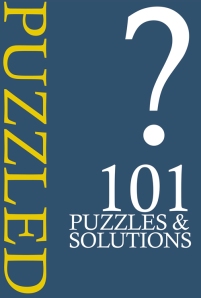On Friday I set this puzzle….
A mother takes two steps to her son’s three. If they go out for a walk together, and each starts with their right foot, when will they first step together with their left foot?
If you have not tried to solve it, have a go now. For everyone else the answer is after the break.
Never. After the mother’s first four steps and the son’s first six steps, the two of them will again step together with their right feet. This cycle will then repeat, ensuring that they never step together with their left feet.
Did you solve it?
I have produced an ebook containing 101 of the previous Friday Puzzles! It is called PUZZLED and is available for the Kindle(UK here and USA here) and on the iBookstore (UK here in the USA here). You can try 101 of the puzzles for free here.


yep 🙂
They’ll never *start* a left step together. They will *finish* a left step together….
The blazes are you talking about?
Thanks, I was thinking that too, but couldn’t word it exactly.
If they can start a cycle with a right step, then they both just made a left step a second earlier.
I think svendersar comment relates to the question: does ‘… each starts with their right foot…’ mean with their right foot on the ground, or stepping forward. I think it means the the latter. Hope this helps.
I think so! Nice one for Marathon day
Yes, this was an easy one and took less than a minute but I needed a piece of paper and a pencil.
That as my initial instinct. But then I plotted it out on a bit of paper and found that they do sync up every 4/6 steps.
If “starts with their right foot” means that they start with the feet together and lift their right foots to make the first step, I agree. This is how I’d interpret it. If the puzzler meant that they both start with the right foot only on the ground and lift the left leg for the first step, it’d be better phrased as “starts on their right foot.” Not very clear what was meant.
Foots? Feet, I meant.
I agree. Saying “If they go out for a walk together, and each starts with their right foot” implies that they are standing still at the start, and starting by taking the first step with the right foot. For example say the child was taking a step every 1s, and the mother every 1.5 seconds:
0:00 Mother and Child start walking
1s Child Right leg hits the ground
1½s Mother Right leg hits the ground
2s Child Left leg
3s Child Right leg, mother left leg
4s Child Left leg
4½s Mother Right leg
5s Child Right leg
6s Child Left leg, Mother left leg
Otherwise you have to assume that the mother’s first step was faster than the 2 steps for every 3 given in the premise.
I’m in step with that answer
I worked it out by walking my fingers. After 2 adult steps, it as clear they wouldn’t sync up.
hmmm. I certainly thought that they were together on a left step at the end of two cycles. Just because they never BEGIN a left step together doesn’t mean they don’t ‘step together.’ Yep, needed to be re-worded.
I have to admit not getting that one, after I thought that I had.
I didnt try it because i doesnt know what means a step: Are “one foot right, then one foot left” two steps or one ? Sorry but the questions arent so precisely, so i thought that was part of the puzzle, to find out that first, and so i let it be…
I interpreted it to mean that the left feet are still on the ground at the start, and the right feet are moving forwards towards the first step. In this case, the answer is after 4 steps and 6 steps respectively.
But I was aware of the fact that the wording could be interpreted in two different ways, in which case the answer might be “never” – but the point is that Richard must also have been aware of this ambiguity, and set the puzzle knowing that it would be kerfufflious accordingly.
John,
We thought that this was an unambiguous question with a clear answer.
Having read some of the above and your explanation and reread the question carefully we have no alternative but to agree with you.
We got the answer wrong as “Never” or half wrong anyway.
T&H
As a musician this was immediately clear. It’s hard to notate here, but imagine playing triplet 8th notes over 4/4 time, meaning 6 beats over 4. A triplet and quarter note only fall simultaneously on 1 and 3. Now imagine the triplets and quarter notes are alternating between lets sat A and D, and both start on A. The triplet and quarter notes will not play the same note at the same time again until 1 of the next measure, and that will be A again. They will never play D together because on 3, the only other time they are in sync, the triplet plays D and the quarter note plays A.
Probably seems convoluted but to me it’s intuitive. One of the few puzzles I got in seconds.
err, let’s say, not let’s sat*
Nice post. I was checking constantly this blog and I am impressed! Very useful info specifically the last part 🙂 I care for such information much. I was looking for this certain info for a long time. Thank you and best of luck.|